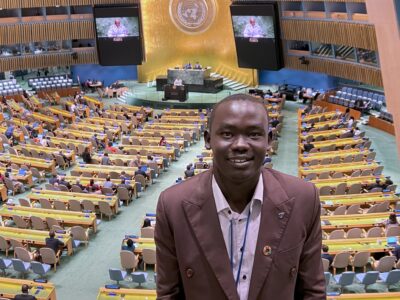
On Tuesday, December 4, students in the Master of Science in Sustainability Management program presented their final Capstone Workshop presentations for fellow students, program faculty, and colleagues at Rennert Hall at Columbia University. This fall’s workshop projects allowed MSSM students to gain experience tackling tough sustainability problems by working with real-world clients, dealing with topics ranging from environmental performance reporting to reducing stormwater runoff.
“The students worked tirelessly to develop a comprehensive strategy for NRDC to achieve net zero energy balance in their NYC headquarters over the next 10 years,” said Kizzy Charles-Guzman, the faculty advisor to the Environmental Performance Reporting Workshop group. “Their technical assessments, strategy criteria, and resulting financial and data models really showcased the range of skills that the students bring to the table and the value that they provide to the clients of this capstone.”
The workshop serves as the culminating educational experience for students enrolled in the program, enabling them to apply the practical skills and analytical knowledge learned through the sustainability management curriculum into an applied project, giving students hands-on managerial experience. The workshop program was designed by the Earth Institute and the School of Continuing Education to integrate the distinct fields of the program’s curriculum as students and faculty work to address critical sustainability management issues. The final briefings are an opportunity to present the results of their semester-long sustainability consultancies to their colleagues.
“The capstone provided a great opportunity to grapple with a complex, interdisciplinary, real-world issue that has no easy answers,” stated Christine Stearn, the presenter for the Stormwater Strategies and Climate Change Adaptation Workshop group. “Thankfully, we he had our faculty advisor, Susanne DesRoches and our client, the New York State Department of Transportation (NYSDOT), led by Elisabeth Kolb and Paul Krekeler, to provide us with the amazing guidance that kept us moving in the right direction.”
The Capstone Workshop is the final degree requirement of the sustainability management program. The workshop serves the purpose of sharpening the students’ analytical and communication skills by allowing them to apply their previous experience and knowledge gained from the program to real-world problems. You can read the descriptions of the fall 2012 Workshop projects below.
Title: Transforming NRDC Headquarters into a Net Zero Energy Facility
Faculty Advisor: Kizzy Charles-Guzman
The Natural Resources Defense Council (NRDC)’s mission to promote a new way of life that does not deplete the earth’s resources or spoil the natural environment has driven the non-profit organization to implement groundbreaking green building retrofits. Comprehensive efficiency measures implemented between 1988 and 2012 have elevated the energy efficiency performance of the NRDC facility to industry-leading levels and received national recognition for leadership in green design. With the “low-hanging fruit” fully leveraged, NRDC set out to achieve the next pinnacle in facility energy performance: net zero energy use, a next-generation designation yet to be achieved by any similar facility. For this unprecedented challenge, NRDC engaged a team of Columbia University students through the fall 2012 Capstone Seminar of the Master of Science in Sustainability Management program. The project team created a detailed implementation plan that married deep energy efficiency retrofits with innovative on-site renewable energy generation technologies. At the onset of the project, NRDC set project constraints and guidelines that guided the team’s methodology. A $5 million budget and 10-year implementation timeline necessitated a full evaluation of up-front investment requirements, payback periods and ROI.
Title: Business Plan for the Healthy Urban Tree Initiative/ New York City
Faculty Advisor: Bob Cook, Wildlife Conservation Society
United States urban forests contain about 3.8 billion trees with an ecosystem service value estimated at $2.4 trillion. Today, many communities are losing tree canopy coverage due to tree and forest destruction through the introduction of non-native insects and diseases such as the Asian long horned beetle, sudden oak death and the emerald ash borer. To meet this threat to urban forests a collaborative and comprehensive approach is required. The workshop team worked with the New York City Healthy Urban Tree Initiative of the Nature Conservancy’s Forest Health Protection Program to define and analyze the components of the program and to assist in the preparation of a business plan that reflects the national strategies to establish coordinating partnerships, assess urban forest health, develop information management, trainings, and tools, engage youth and the public in tree stewardship, and raise public awareness through outreach and communications strategies.
Title: Stormwater Strategies and Climate Change Adaptation
Faculty Advisor: Susanne DesRoches
There is overwhelming scientific consensus that global climate change is occurring, and its effects are being observed in New York State. Rain downpours, a forecasted climate change impact, are on the rise in the Northeast, posing an increasing threat to transportation infrastructure. To manage this threat, communities and municipalities need tools and information that will allow them to make decisions about when and how to protect transportation infrastructure.
A key strategy is reducing stormwater runoff from severe rainfall events. In urban settings, excess stormwater during downpours overwhelms the combined sewer overflows systems, reducing water quality and creating public health issues. In suburban areas, drainage structures, such as culverts and ditches, may be unable to covey the volume of water leading to infrastructure failures and flooding. By reducing the volume and flow of stormwater runoff, transportation infrastructure can become more resilient to the impacts of climate change. Using green infrastructure concepts, natural environments can increase water infiltration and storage capacity, mitigating the effects of increased downpours.
The New York State Department of Transportation (NYSDOT) is seeking a compendium of best practices for reducing stormwater runoff in urban and sub-urban settings. This information would assist transportation agencies and communities in making informed climate change adaptation decisions and reducing the impacts to infrastructure caused by extreme rainfall events. The task of the workshop team was to compile a list of best practices that included relevant climate projections for New York State and detailed stormwater runoff best practices for adaptation and urban and suburban case studies.
Title: PlaNYC: Conduct a Study to Assess Diversion of Commercial Organic Waste from Landfills
Faculty Advisor: Louise Rosen
Every year, New York City creates more than 14 million tons of waste. Roughly half is recycled. A quarter is collected from our homes, streets and public institutions. Another quarter is collected from businesses, including offices, restaurants and manufacturing. The rest comes from the construction and demolition industry, including fill or dirt from excavation. Managing this vast amount of solid waste has an enormous impact on our environment, communities and economy. Currently, solid waste represents 3 percent of the city’s greenhouse gas emissions.
The task of the workshop group was to conduct an assessment of commercial organic waste generators (including restaurants, cafeterias, supermarkets, etc.), and to assess opportunities for diversion for each category of generator, either through collection by a 3rd party or on-site processing. The group developed policy recommendations and outlined best practices including mapping food generation “locations” across the city and identifying the impacts of different diversion strategies – in terms of number of trucks, community impact, etc.
Title: Resilient Sustainable Communities: Integrating Hazard Mitigation and Sustainability in Local Planning
Faculty Advisor: George Sarrinikolaou
Working with the Environmental Protection Agency (EPA) and the Federal Emergency Management Agency (FEMA), the student team’s task was to take on a fundamental challenge in sustainability: integrating environmental concerns in economic activity. In this project, the driver of that integration was hazard mitigation, which, as we are learning, is often enhanced by sustainability. Green infrastructure, for example, can reduce a community’s vulnerability to flooding; distributed power generation can boost the resilience of a place to power outages. The team’s assignment was to facilitate this sort of integration in the work of the Syracuse/Onondaga County Planning Agency. The project involved examining a small number of the organization’s community planning documents (e.g. land-use and economic development) in order to accomplish the following: 1) develop a methodology that could be used in the plan review process to align plans and to identify inconsistencies that run counter to hazard mitigation and sustainability; 2) highlight opportunities to include hazard mitigation and sustainability. The student team worked in consultation with FEMA, EPA and planning agency staff.



